
A newly discovered planet, named TWA 7b, has been found about 110 light-years from Earth. This exciting find comes from NASA’s James Webb Space Telescope, marking the first time this powerful telescope has directly spotted a planet outside our solar system.
The discovery is especially exciting because it offers a rare glimpse at a very young planetary system—only about six million years old. According to Dr. Anne-Marie Lagrange, the lead astrophysicist on the project, it’s like looking at a solar system in its early childhood.
The James Webb Telescope, which launched into space in 2021, has already made many groundbreaking discoveries. Over the past year alone, it has identified icy rings forming around a young star, helped find a massive rocky planet called a “super-Earth,” and even located a planet that scientists believe could have the best chances of supporting human life. And that’s just a small part of what it has done so far.
This latest discovery was made possible thanks to scientists from France’s National Centre for Scientific Research (CNRS), who used the Webb Telescope to track down the new planet.
The James Webb Telescope is an advanced piece of technology designed to explore deep space. It took years to build, cost around \$10 billion, and is loaded with some of the most powerful scientific instruments ever sent into space. It has a massive 6.5-meter mirror that helps it collect light from very far away, making it much more sensitive than older telescopes like Hubble. Because of its advanced design, Webb can see things that happened near the beginning of the universe and peek inside dense clouds of dust where stars and planets are still forming.
The new planet, TWA 7b, is what scientists call an “exoplanet,” which simply means it orbits a star that isn’t our Sun. More than 5,800 exoplanets have been confirmed so far, but experts believe there could be billions out there. Most of the ones we’ve found are in our own galaxy, the Milky Way. The nearest known exoplanet is still about four light-years away.
Why do exoplanets matter? By studying them, scientists can learn what other worlds are made of. Some are rocky like Earth or Venus, others are gas giants like Jupiter or Saturn. There are even strange ones—planets made mostly of ice or iron, or ones with lava-covered surfaces.
What makes TWA 7b stand out is that it’s much smaller than most exoplanets we’ve captured images of before. It was spotted orbiting a young star called TWA 7, located in the constellation Antlia. The planet was hiding in a ring of dust and debris around the star, and scientists were only able to see it thanks to a special tool on the telescope called a coronagraph. This device blocks out the star’s bright light, a bit like wearing sunglasses, so the much dimmer planets nearby can be seen.
TWA 7b has a mass similar to Saturn—only about a third the size of Jupiter, the biggest planet in our solar system. This makes it one of the smallest planets ever directly imaged with a telescope. Scientists hope that in the near future, with even better technology, they’ll be able to spot planets even smaller—maybe even ones closer in size to Earth.
This discovery is a big step forward in the search for distant planets and shows just how powerful the James Webb Telescope really is. And since it’s just getting started, there’s a good chance it will uncover even more amazing things soon.




